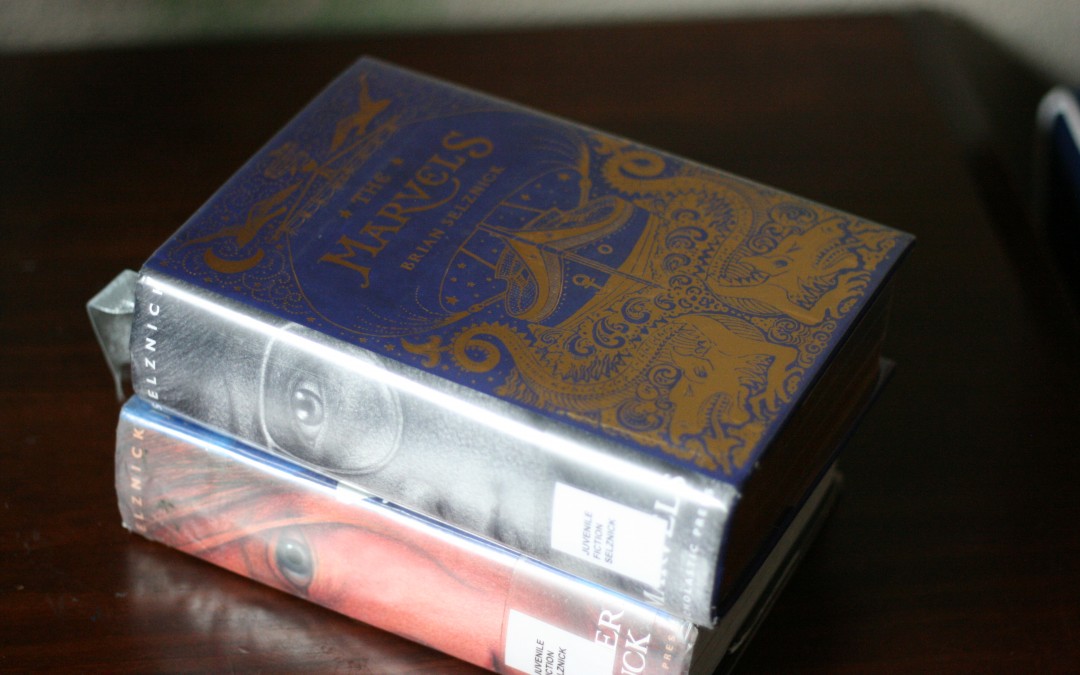I’ve been a little obsessed lately with the middle grade author Brian Selznick. He’s not actually just an author. He’s an author illustrator for middle grade, which isn’t a common combination when you start moving into books for older grades, unless we’re talking about a graphic novelist. But Selznick isn’t that, either. He has a very unique style of writing his books—using both prose and picture.
I was first introduced to Selznick back when I read his The Invention of Hugo Cabret, which was released in 2007 and was turned into a movie in 2011. This book is aimed at 8- to 12-year-olds but is 533 pages long. Most of those pages, though, are illustrations, which I find charming about Selznick and his style. He writes his books for middle grade readers, and they’re all more than 500 pages, so by the time a kid finishes a Selznick book, he or she feels incredibly accomplished. Do you remember the first 500-page book your read? My oldest was 7 when he read the Invention of Hugo Cabret, and it was the longest book (and heaviest book) he’d ever held in his hands.
So recently I went back and read two of Selznick’s other books that my oldest son has already read. The first was WonderStruck, which is a story about a boy named Ben who just lost his mother. He’s living with his aunt and uncle in a cabin that’s right across the way from the cabin he used to share with his mom. One night, he’s in his old abandoned cabin, and the phone rings. He answers it and is struck by lightning, which renders him deaf.
From there, he goes on an adventure to find his father, who was never around when he was a kid. There’s a bit of a mystery about his father and where he is. His story collides with the story of Rose, a deaf child whose mother was a famous actress. Their stories are set fifty years apart, so by the time their paths cross, Rose is an old woman. Selznick weaves Rose’s story into Ben’s using beautiful illustrations.
WonderStruck is a rich and entertaining read perfect for readers who are a bit shy about picking up those larger books. The pictures make the book feel as if the reading of it is much easier than it first appears.
The other book of Selznick’s I read was The Marvels, which was released last year. It begins with Selznick’s characteristic illustrations, telling the story of a theater family. It then switches to prose for the story of Joseph Jervis and Albert Nightingale. Joseph runs away from his private school and goes to London to seek refuge with the uncle he’s never met. The house where his uncle stays is cloaked in mystery. Selznick is a master at keeping his readers turning the pages—whether to see his brilliantly executed drawings or to find out what happens next.
The Marvels touched on themes like forgiveness, moving on with life after tragedy strikes, and doing something about changing your life if you don’t like the way it’s playing out. Selznick’s characters are rich with their own backstories, and even though Uncle Albert is a bit difficult to get to know, readers will identify with him once he opens up.
Here’s a quote from The Marvels that showcases Selznick’s blend of descriptive and engaging prose.
“At the end of the hallway was the staircase Uncle Albert had told him to climb. But to his right, just beyond the painted shipwreck, were shiny black double doors that opened into the dining room he’d seen from the street. Inside, the fire hissed and snapped and cast flickering shadows across the glossy green walls. Joseph couldn’t help himself. Mesmerized, he put down his suitcase and felt himself pulled into the room, like a moth fluttering helplessly towards the light.”
I enjoyed both of these books, because while they were simplistic reads, it took quite a lot of imagination to dream them up. And the illustrations made the books charming and lovely.
I hope you enjoyed these book recommendations. Be sure to pick up your free books from my starter library and visit my recommendation page to see some of my best book recommendations. If you have any books you recently read that you think I’d enjoy, leave them in the comments and I’ll add them to my list.
*The books mentioned above have affiliate links attached to them, which means I’ll get a small kick-back if you click on them and purchase. But I only recommend books I enjoy reading myself. Actually, I don’t even talk about books I didn’t enjoy. I’d rather forget I ever wasted time reading them.


